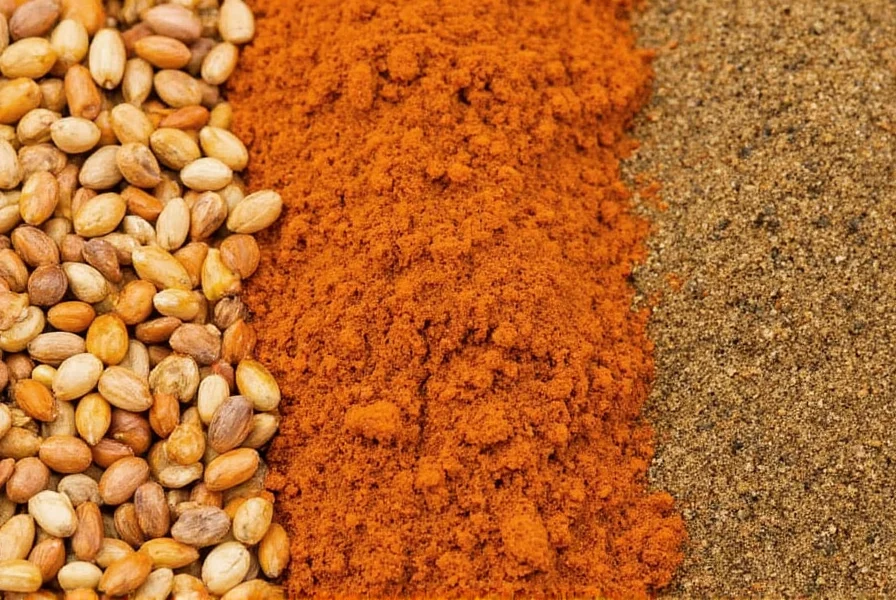Many people mistakenly believe curcumin and cumin are interchangeable terms or products. This confusion creates real problems when people seek health benefits or attempt recipes. Understanding the difference matters for both culinary accuracy and making informed decisions about dietary supplements.
What Exactly is Cumin?
Cumin (Cuminum cyminum) is a flowering plant in the Apiaceae family, native to the Middle East and India. The spice we call cumin comes from the dried seeds of this plant. These small, crescent-shaped seeds have a warm, earthy flavor with a distinctive nutty aroma that's essential in many global cuisines.
Chefs and home cooks use cumin extensively in:
- Mexican and Tex-Mex dishes like chili and tacos
- Indian curries and spice blends
- Middle Eastern recipes including falafel and hummus
- North African tagines and spice mixes
Cumin provides both flavor and potential health benefits. It contains compounds like cuminaldehyde that may support digestion and have antioxidant properties. When you buy cumin at the grocery store, you're getting the whole seed—either whole or ground—of the cumin plant.

Understanding Curcumin: The Golden Compound
Curcumin is a naturally occurring polyphenol and the primary bioactive compound in turmeric (Curcuma longa), a plant in the ginger family. Turmeric root contains only about 2-8% curcumin by weight, with the rest consisting of other curcuminoids and compounds.
When you see bright yellow turmeric powder at the store, curcumin is responsible for that vibrant color. However, curcumin itself is typically extracted and concentrated for supplement use because the concentration in whole turmeric is relatively low.
Research has investigated curcumin's potential anti-inflammatory and antioxidant effects. Many people take curcumin supplements seeking support for joint health, though it's important to note that curcumin has low bioavailability on its own. That's why quality supplements often include black pepper extract (piperine) to enhance absorption.

The Critical Relationship Between Turmeric and Curcumin
This is where much of the confusion originates. Curcumin comes from turmeric, not from cumin. Turmeric is the plant (a rhizome similar to ginger), while curcumin is one specific compound within turmeric.
| Component | Source Plant | Plant Family | Nature | Primary Use |
|---|---|---|---|---|
| Curcumin | Turmeric (Curcuma longa) | Zingiberaceae (Ginger family) | Chemical compound (polyphenol) | Dietary supplement, coloring agent |
| Cumin | Cumin (Cuminum cyminum) | Apiaceae (Parsley family) | Whole spice (seeds) | Culinary spice |
| Turmeric | Turmeric plant | Zingiberaceae (Ginger family) | Whole root/rhizome | Culinary spice, traditional medicine |
Why People Confuse Curcumin and Cumin
The similar pronunciation creates understandable confusion. Both words begin with "cur-" and sound vaguely similar to English speakers. This linguistic coincidence has led to widespread misunderstanding, particularly in wellness circles where curcumin supplements have gained popularity.
Another factor is the growing interest in turmeric's health benefits. As people search for "turmeric supplements," they encounter the term "curcumin" and mistakenly associate it with the more familiar spice "cumin." This confusion sometimes appears even in casual conversations among health-conscious individuals.
Practical Implications of the Difference
Understanding this distinction has real-world consequences:
Culinary Applications
You cannot substitute turmeric (or curcumin) for cumin in recipes. They have completely different flavor profiles. Cumin has a warm, earthy, slightly bitter taste, while turmeric has a more subtle, slightly bitter, and earthy flavor with less complexity. Using one in place of the other will significantly alter your dish's intended flavor.
Supplement Considerations
If you're seeking the potential health benefits associated with curcumin, you need either high-quality turmeric supplements with standardized curcumin content or purified curcumin extracts. Regular cumin seeds or powder won't provide these specific compounds.
Conversely, if you're looking for the digestive benefits traditionally associated with cumin, turmeric or curcumin supplements won't deliver the same effects, as they contain different active compounds.
Addressing Common Questions
Many people wonder about substituting these ingredients or understanding their health profiles. Let's clarify some frequent points of confusion:
- Can I use cumin instead of turmeric for health benefits? No—they contain different compounds with different potential effects.
- Does cumin contain curcumin? No—curcumin is exclusive to turmeric and related plants in the ginger family.
- Is ground turmeric the same as curcumin? No—turmeric contains curcumin along with other compounds, but in relatively low concentrations.
Conclusion
Curcumin and cumin represent a classic case of botanical confusion due to similar names but entirely different origins and properties. Curcumin is a specific compound in turmeric with potential wellness applications, while cumin is a standalone spice essential to many culinary traditions. Recognizing this difference helps you make better choices whether you're following a recipe or selecting supplements.
When encountering health claims or recipes, always check whether they reference turmeric/curcumin or cumin—your cooking and wellness decisions will be more informed as a result. This knowledge empowers you to navigate both the spice aisle and supplement market with greater confidence.











 浙公网安备
33010002000092号
浙公网安备
33010002000092号 浙B2-20120091-4
浙B2-20120091-4